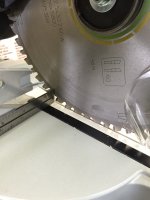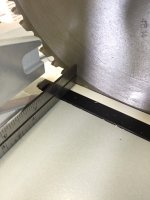I actually think variable speed and torque control is a valuable. Maybe most do not take advantage of this. More people should. Just like the variable speed on the track saw. Running the saw on full tilt buggy is not the optimal way to use it. Think about cutting plastics, phenolics and such. Try reducing rpm and feed rate and you might be surprised at the surface finish that can be achieved as well as appropriate chip load.
You are using an out of date browser. It may not display this or other websites correctly.
You should upgrade or use an alternative browser.
You should upgrade or use an alternative browser.
Is the Kapex tough? My experience to date.
- Thread starter Woodhack
- Start date
Regarding
and
What burns out in the Kapes mainly seems to be the armature (winding), not the control board.
That makes me think toward a thermal problem (heat not been removed quick enough from the motor leading to resistance increase, which increases heat generation, leading to a death spiral), a vibration issue (wires in the winding breaking from being able to move too much, yielding a high resistance spot that eventually melts and/or arcs) or an insulation issue (wires in the winding touching and able to move, vibrations scratching the insulation away leading to a short-circuit, arcing, meltdown).
tallgrass said:With a little test bench testing "borrowed KApex from a friend" I have found that if you do this, the behavior found on the oscilloscope closely matches that of the track saw, which do not seem to have this problem.
and
tallgrass said:This means of control may not be tolerant to certain use regimes. [...] I think it is the pulsing of the system and under load combined with the frequency at which this happens may be playing havoc with the control system.
What burns out in the Kapes mainly seems to be the armature (winding), not the control board.
That makes me think toward a thermal problem (heat not been removed quick enough from the motor leading to resistance increase, which increases heat generation, leading to a death spiral), a vibration issue (wires in the winding breaking from being able to move too much, yielding a high resistance spot that eventually melts and/or arcs) or an insulation issue (wires in the winding touching and able to move, vibrations scratching the insulation away leading to a short-circuit, arcing, meltdown).
James Biddle
Member
- Joined
- Jan 24, 2007
- Messages
- 162
^^^^ this one
I just remembered the infamous TS 55 teardown, while the guy had quite some stuff wrong (like the bearing on the blade side) there's the comment about the motor winding which seems reasonable to me.
Which could, in case the Kapex armature is made similar (wires not being dipped and able to vibrate freely), well explain why the motor goes up in flames.
In case anyone dosn't trust the short link: search for AvE Festool Track Saw TS 55 on youtube and jump to 21:09.
Which could, in case the Kapex armature is made similar (wires not being dipped and able to vibrate freely), well explain why the motor goes up in flames.
In case anyone dosn't trust the short link: search for AvE Festool Track Saw TS 55 on youtube and jump to 21:09.
Sorry, I have had to delete the video shortner originally listed in the thread above. You can certainly go to Youtube and search for the video though.
Peter Halle - Moderator
Peter Halle - Moderator
Reading up on motors and dipping I found this link into google books which describes the potential failure modes for windings that are not dipped.
By conincidence these correspond quite well to what I posted this morning, now i'm keen on taking a look at a Kapex motor from the inside - but don't quite feel like disassembling mine, yet. Maybe someone with a failed out of warranty one is willing to take a look for us and post some photos of the windings (and, if visible, the fault location)?
By conincidence these correspond quite well to what I posted this morning, now i'm keen on taking a look at a Kapex motor from the inside - but don't quite feel like disassembling mine, yet. Maybe someone with a failed out of warranty one is willing to take a look for us and post some photos of the windings (and, if visible, the fault location)?
HandyDen
Member
- Joined
- Sep 26, 2017
- Messages
- 53
tallgrass said:I think best practices are to allow the blade to come to steady state , make cut and then allow the blade to come to a complete stop.
I understand why it would be helpful to allow the saw to come up to speed before starting the cut. What I don’t get is the benefit of allowing the blade to come to a complete stop? Do you mean not letting the saw pivot up until it’s stopped? If so, why?
I REALLY want a Kapex, but these discussions certainly cause me pause.
RJNeal
Member
Because Handyden, the small pieces go flying.. I don’t stop much on larger pieces but small pieces and trim returns I not only don’t raise the blade before it stop I even let off the on switch right before the saw completes its cut because I even got tired of the small pieces getting suck up with the movement of air that the blade makes.
Hope this explains this.
Rick.
Hope this explains this.
Rick.
I have not seen any of the saw that have died. So there may be failure mods that are not obvious to me. Blown wingdings is interesting. Something to ponder. It is my understanding that all of the saw motors are produced int he same way. So why are we not finding the same failure on the track saws? Interesting.
Possibly becuase the Kapex head is attached to a fixed axis. The movement of the saw head (after completing a cut) against the end stop might generate shock waves that come with a somewhat reproducible vector, which could be worse than shocks from random directions.tallgrass said:Blown wingdings is interesting. Something to ponder. It is my understanding that all of the saw motors are produced int he same way. So why are we not finding the same failure on the track saws?
Letting go while moving the saw head up (as time is money) might increase the forces generated.
Possibly one also starts the Kapex more often than a TS, one of the moments with highest load (thus the strongest vibrations in the wires from the oscillating magnetic field they create) is while spinning up from standstill.
Havn't had enough coffee this morning yet so please take all of this just as pore speculation that is ment for an awake brain to rethink.
Birdhunter
Member
- Joined
- Jun 16, 2012
- Messages
- 4,150
I think Tallgass may have a good point.
My Kapex is a very experienced machine used mostly for cutting hardwood from oak to Ipe to ebony.
I’ve always let the machine run for a few seconds to get the airflow moving well and to warm up the motor. I moderate the cut based on both sound and feel. I don’t force the machine.
I always vacuum the machine after every use and I try to vacuum out the motor vents.
All this probably sounds obsessive, but I do the same for all my tools. I’ve never had an equipment failure in 40 or so years of Woodworking.
My Kapex is a very experienced machine used mostly for cutting hardwood from oak to Ipe to ebony.
I’ve always let the machine run for a few seconds to get the airflow moving well and to warm up the motor. I moderate the cut based on both sound and feel. I don’t force the machine.
I always vacuum the machine after every use and I try to vacuum out the motor vents.
All this probably sounds obsessive, but I do the same for all my tools. I’ve never had an equipment failure in 40 or so years of Woodworking.
Jaybolishes
Member
- Joined
- Apr 16, 2012
- Messages
- 400
I read a number of people who claimed wood would catch the blade and slam up against the guard and break it because the parts were plastic. I wonder if the new design coming out has remedied this problem? Letting saws speed up and slow down for fear of what may happen really narrows down the builders who would use it. Then there's the advice festool gives about not plugging the kapex through the saw if you're cutting thicker material, its ok to plug through the vac cutting thinner material. I mean its a head spinner. Then there's the people who have said the saw lacks power compared to every other saw. Lots of things come to mind but the question in the subject is toughness which definitely is lacking.
Tyler Ernsberger
Member
- Joined
- Sep 30, 2014
- Messages
- 895
I have the theory but I’m not sure. The Festool vacs are rated at 6.3 amps at the outlet on the front of the vac. The Kapex is probably running at 12amps under load. That could be an issue. Festool says that the Kapex should be plugged into a 20amp outlet. If the Kapex is that sensitive about it’s power supply why would Festool Vac only be rated at 6.3 amps and why is Festool reducing the size of the cords on the newer vacs to 16 gauge.
I do not own I Kapex. I have many friends that have had theirs go up in smoke. They are professional carpenters that use the Kapex all day long. I use Dewalt 716 and Hitachi C10fsh, both of these saws are accurate and stand up to use.
[member=2242]tallgrass[/member] let me know if this is a possibility. Thanks
I do not own I Kapex. I have many friends that have had theirs go up in smoke. They are professional carpenters that use the Kapex all day long. I use Dewalt 716 and Hitachi C10fsh, both of these saws are accurate and stand up to use.
[member=2242]tallgrass[/member] let me know if this is a possibility. Thanks
Ben63
Member
- Joined
- Aug 29, 2018
- Messages
- 15
I think my Kapex 120 UG is far the best saw I ever used. Many years ago I worked with about 15 woodworkers on a shipyard. Most of them did not like the Kapex. I never understood why. Felt like they had no feeling of wood or machines, they just worked from 8-16 and had no real interest in the work. As we say here; its like giving pearls to pigs.
DeformedTree
Member
- Joined
- May 19, 2018
- Messages
- 1,397
Birdhunter said:I’ve always let the machine run for a few seconds to get the airflow moving well and to warm up the motor. I moderate the cut based on both sound and feel. I don’t force the machine.
I always vacuum the machine after every use and I try to vacuum out the motor vents.
All this probably sounds obsessive, but I do the same for all my tools. I’ve never had an equipment failure in 40 or so years of Woodworking.
No, you use your tools properly. All tools be it a hammer or a complex saw require a level of care. Nothing is designed to be completely trashed all the time. Cleaning tools is one of the most important things to due to them and something many folks don't do. Especially cleaning out the air flow paths in them.
Jaybolishes said:etting saws speed up and slow down for fear of what may happen really narrows down the builders who would use it. Then there's the advice festool gives about not plugging the kapex through the saw if you're cutting thicker material, its ok to plug through the vac cutting thinner material. I mean its a head spinner. Then there's the people who have said the saw lacks power compared to every other saw. Lots of things come to mind but the question in the subject is toughness which definitely is lacking.
Any motorized device needs to be allowed to spin up. This air flow going across the electrical components and gets the bearings going before heavy loading. If you just start slammed into material or don't let it get going to full speed before cutting you are just increasing the amps the motor is going to draw and creating a stall condition. Electronics of any form don't like sudden load changes (in rush currents), nor do they like sudden temp changes. Running a tool after a cut is important for letting air flow thru the electronics after the heavy load has been removed to allow it to cool down. No different than using a drill that gets hot, you remove the load but you keep it running un-loaded to allow the fan to cool it down internally.
If folks are just slamming tools into material, not allowing them to cool down with fans after cuts, just letting go of the handles and letting them fly back up , etc they simply should not be operating tools. Both for the tools good and for their own personal safety.
You can always add some margin into tools, but there are limits to what engineers can do. Both cost wise and weight wise. You can really add some margin into the thermal design of a tool by adding more metal to it, but not only does it add cost but now it becomes heavy as heck and people will complain about that. I don't think anyone would disagree that Festool cut things a bit too close on the Kapex, at least with the 120V model.
Festool clearly made the Kapex for portability and focused on more finished work jobs. I don't see it being apples to apples with saw like a Dewalt 718. The dewalt wights almost 10lbs more (which is a killer extra 10lbs when you move it around). Sure the dewalt is designed to cut 2x12 and other rough lumber well, but that's about all it does. And you have to baby it even though it's a bigger and more powerful saw. You can cut a lot of material with it but it will also come to a halt on some cuts, any random board will sometimes just give a fight. You have to let it work it, not force it. It also blows dust everywhere. Would have I traded my dewalt for a kapex the last few years, probably not, even though I would have loved the dust collection, I just don't see it wanting to do a lot of the rough construction work, and doing stuff like cutting lots of pressure treated lumber, etc. But would I go for a new Kapex in the coming years as I shift over to more finished work, very possible. I would still keep the dewalt around for certain task (chopping thru lumber piles). Just like my assortment of circular saws won't go anyplace because they will always have a purpose for some task. I'm not going to take my track saw and start cutting stone and concrete with it.
Jaybolishes
Member
- Joined
- Apr 16, 2012
- Messages
- 400
Nice write up. So is the kapex tough? I feel that explanation leans towards it’s not, which is fine it’s only a trim saw.
Cheese
Member
Jaybolishes said:I read a number of people who claimed wood would catch the blade and slam up against the guard and break it because the parts were plastic.
The first photo is when I first received my Kapex from Festool. That's a steel rule placed against the fence to gauge how many tooth edges of the saw blade are still above the bed and thus are capable of propelling any small offcuts like bullets.
[attachimg=1]
The second photo is after the blade height was adjusted properly. There are now no visible tooth edges and the offcut issue went away.
[attachimg=2]
Attachments
pettyconstruction
Member
- Joined
- Oct 17, 2010
- Messages
- 722
I think one of the problems is the speed control,my other saws don’t have that .
Maybe to much electronics in the mix.
Charlie
Sent from my iPhone using Tapatalk Pro
Maybe to much electronics in the mix.
Charlie
Sent from my iPhone using Tapatalk Pro
Kodi Crescent
Member
- Joined
- Aug 6, 2010
- Messages
- 791
HandyDen said:tallgrass said:I think best practices are to allow the blade to come to steady state , make cut and then allow the blade to come to a complete stop.
I understand why it would be helpful to allow the saw to come up to speed before starting the cut. What I don’t get is the benefit of allowing the blade to come to a complete stop? Do you mean not letting the saw pivot up until it’s stopped? If so, why?
I REALLY want a Kapex, but these discussions certainly cause me pause.
You let the blade stop before lifting the head because the spinning blade may catch the edge of what you just cut. Smaller pieces are thrown, larger pieces are chipped or marked, reducing the quality of the cuts.
Woodhack
Member
- Joined
- Feb 2, 2014
- Messages
- 33
I didnt realize there would be so many replies to this.
Im gonna try to attach some pics of the outside upper section that is done. Working on the lower outside framing now with the front plyed up.
The Kapex is framing away. Im cutting 2x12, 2x10 out the wazoo even a glue lam type beam that almost crushed my paulk bench outrigger
Ill post more pics of the facade in the sun
Im gonna try to attach some pics of the outside upper section that is done. Working on the lower outside framing now with the front plyed up.
The Kapex is framing away. Im cutting 2x12, 2x10 out the wazoo even a glue lam type beam that almost crushed my paulk bench outrigger
Ill post more pics of the facade in the sun




